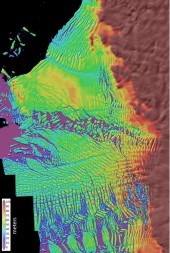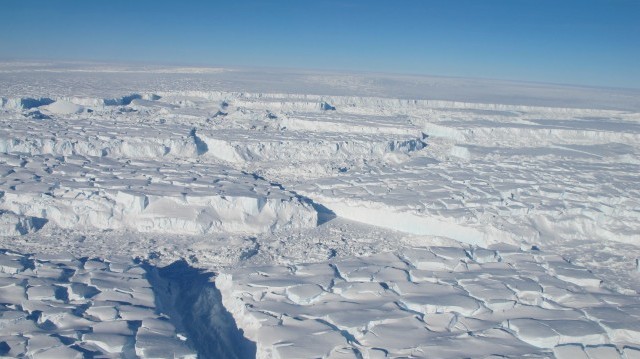Global sea levels are rising at an accelerating rate. Google Maps of Sea Level Rises will even calculate the impact of rising oceans on your home town. Though the disappearance of Manhattan feels like a distant threat, recent research from the University of Washington indicates the melting of Antarctic glaciers may be happening sooner than previously expected.
A study published in the journal Science focuses on the Thwaites Glacier, the largest ice sheet on the particularly vulnerable West Antarctic Ice Sheet. It uses new data from airborne radar developed at the University of Kansas to map the underlying bedrock. Earlier studies did not clarify whether there might be topographic features or "bumps" below the ice that would stabilize the glacier and slow its descent into the warmer surrounding waters. According to lead author Ian Joughin, a glaciologist at the University of Washington’s Applied Physics Laboratory, "There’s no real stabilizing mechanism we can see."
Glaciologist Eric Rignot of NASA's Jet Propulsion Laboratory and the University of California, Irvine, describes the decline of six rapidly melting glaciers in West Antarctica.

The team combined the new radar data with data from instruments that measure the ice sheet’s rapidly thinning surface and UW’s own satellite-derived measurements of ice surface speeds. They developed a computer model that accurately reproduces the glacier’s ice loss during the past 18 years, and predicts the future melt. Their peek beneath the icy surface reveals the leading edge of the glacier resting on a ridge that physically limits its descent into the warmer surrounding waters. Once the heavy ice sheet melts back beyond this ridge, it will discharge ice to the ocean at a faster rate.
Depending on the rate of ocean warming, collapse of the Thwaites is expected to happen in between 200 and 1,000 years. And since the Thwaites Glacier acts as a linchpin, with its disappearance the entire West Antarctic Ice Sheet is likely to follow rapidly, raising ocean levels by 10-13 feet. Program that into Google Maps of Sea Level Rise, and you might be surprised. According to Joughin, "All of our simulations show it will retreat at less than a millimeter of sea level rise per year for a couple of hundred years, and then, boom, it just starts to really go."
